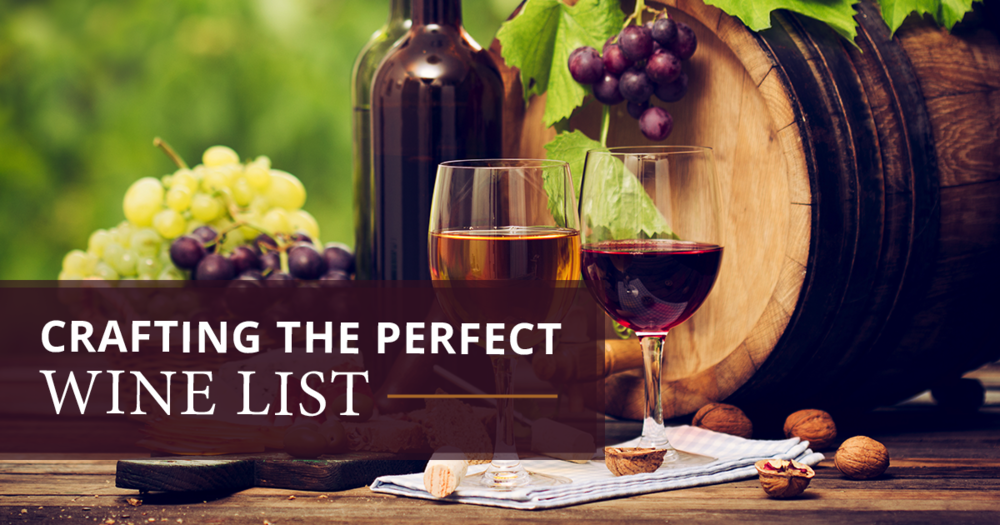Crafting The Perfect Wine List

There’s nothing quite like the experience of a fine meal with a perfectly paired wine. Wine lists at restaurants offer diners the opportunity to select the perfect pairing from an impressive list of choices. While a wine list is not suitable for every restaurant, there is certainly an opportunity to offer wine to compliment many types of food and cuisine. Not only will a well-crafted wine list increase the average meal check as well as overall profits, it can also attract new customers looking for a more upscale dining experience featuring finely paired wines.
Keeping Your List Short and Sweet
Unless you are running a high-end establishment, the days of wine lists containing hundreds of fine wines from around the world have become a thing of the past. Keeping your list narrowed down to a handful of carefully selected wines that pair well with the other items on your menu keeps customers from feeling intimidated and overwhelmed.
Breaking your list down into clear sections containing similar wines allows your customers the opportunity to quickly grasp the choices available to them. In most cases, you'll be stocking a variety of both light and full-bodied white and red wines. Sparkling whites are also popular with certain food choices. Don't forget a section containing dessert wines, especially if your restaurant features special dessert options.

Don't Forget True Wine Connoisseurs
Keeping your wine list organized to contain a smaller number of choices doesn't mean you can't cater to true wine connoisseurs. While the majority of wines on your list should be somewhat familiar to most people, adding in a few that are more unique, rare, and/or expensive is can also be appropriate. A new wine may be just the thing for wine-loving patrons or those celebrating a special occasion.
Match Your Wine List to Your Food Options
When creating the perfect wine list for your establishment, food pairing concepts are critical in providing your customers a pleasurable dining experience and increasing overall profits. Bear in mind the following general principles, then craft your list based on which foods are served at your restaurant:
- Full-bodied red wines are best paired with any dish containing red meat, savory mushrooms, and/or black pepper as a dominant flavor or ingredient.
- Medium-bodied red wines work well with foods containing tomato based sauces, roasted vegetables, and/or strong spices such as cumin, allspice, chili peppers, and/or rosemary.
- Lighter red wines pair well with poultry dishes.
- Full-bodied white wines also pair well with poultry dishes; additionally, they bring out the flavor in crab, lobster, cream sauces, cheeses, and more.
- Lighter-bodied, dry white wines work best with seafood (including sushi), chilled salads, and fried foods.
- Fruity, floral white wines, with their aromatic appeal, pair well with Indian, Thai, and citrus-based dishes, as well as pungent cheeses or sauces and even certain sweet treats like ice cream.
- True dessert wines, with significantly sweeter flavors compared to other wines, are excellent when served with pies, chocolate, caramel, and cakes of many varieties. They also work well with the strongest flavored cheeses.
- Sparkling wines and champagnes are wonderful served with fried foods of all types and anything with a strong salty flavor.

Use Menu Psychology to Encourage Higher Wine Sales
You may be surprised to learn the significant impact the design of a wine menu has on generating higher meal checks. Something as simple as keeping the entire list free of the dollar sign symbol can steer customers away from fears about spending money. Design elements such as the placement, description, and organization of each items matters more than most of us realize.
Following a few menu design principles can generate a higher profit for your restaurant:
- Place your most profitable items at either the beginning or the end of the wine list, as these are the portions of the menu that the majority of people will read.
- Place a higher profit, "premium" option next to a less expensive wine to encourage customers to "splurge" and treat themselves to something of higher quality.
- Use descriptive terms, but don't be too wordy when describing each wine you offer. This is not the place to copy the back of the wine label. You may choose to list the basic characteristics and flavors of each wine, such as "crisp" or "oaky."
When it comes to describing wines, there is an art to creating just the right message to make mouths water and wallets open. Dave Baloun, from Elevage Wine Advisors, recommends keeping your wine list simple and understandable, but also interesting and informative.
“Provide brief descriptions of the wines to encourage patrons to order wines based on their flavor components,” Baloun says. “If you have properly chosen wines that accompany your food, make recommendations as to natural pairings. Get creative and attempt to motivate your customers to have a pleasant experience when using your wine list.”
Higher Meal Checks and Happier Customers
Creating the perfect wine list is the perfect way to increase meal checks at your establishment while simultaneously pleasing your customers more than you ever have before. Restaurants with succinctly organized wine menus that don't overwhelm customers encourage extra spending and the deeper enjoyment of one's meal.
With the help of menu psychology, menu designs can further increase profits without having to expand menu choices. Don't forget to educate your servers and staff about the items on your wine list, as even the best wines become hard to sell when they aren't understood by the people that interface with customers the most. By providing your patrons with a well-crafted list of complimentary wines, they can enjoy their dining experience even more.
Categories
Recent Posts
- Why Re-Branding Your Restaurant Is The Key to Providing a Better Customer Experience
- The Ultimate Guide To Restaurant Menu Fonts
- The Top Resources To Help You Design Your Own Menu
- Crafting The Perfect Wine List
- 5 Restaurant Blogs That Will Help You Make More Money In 2016
- Are Secret Menu's The Secret Sauce To Avid Fans
- Infographic - Reasons For Keeping The Tipping System
- Why Tipping Is Better For Diners And Servers
- How To Manage Your Online Reviews: The Good And The Bad
- Next Level Restaurant Branding Featuring Nice Branding Agency
- The Start To Finish Guide To Creating Your Own Menu
- 10 Restaurants Really Cooking With Facebook Marketing
- 6 Things You Can Do Today To Boost Your Restaurants Brand
- 8 Menu Types You Should Know About
- Next Level Restaurant Branding Featuring: Vigor
- Are Restaurant Loyalty Programs Worth It?
- 7 Restaurants Doing Dining Differently
- Judging a Restaurant By Its Menu
- Three Major Tips for Effective Restaurant Management
- 6 Tips to Get More People into Your Restaurant
